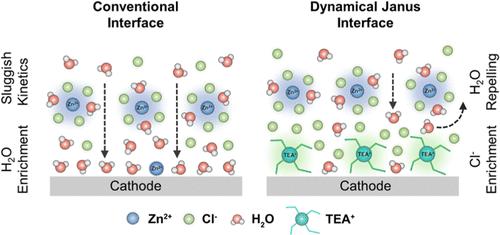当前位置:
X-MOL 学术
›
J. Am. Chem. Soc.
›
论文详情
Our official English website, www.x-mol.net, welcomes your feedback! (Note: you will need to create a separate account there.)
Dynamical Janus Interface Design for Reversible and Fast-Charging Zinc–Iodine Battery under Extreme Operating Conditions
Journal of the American Chemical Society ( IF 14.4 ) Pub Date : 2024-07-24 , DOI: 10.1021/jacs.4c03615 Wei Zong 1, 2, 3 , Jiantao Li 4 , Chengyi Zhang 5 , Yuhang Dai 2, 3 , Yue Ouyang 1 , Leiqian Zhang 1 , Jianwei Li 2 , Wei Zhang 2 , Ruwei Chen 2 , Haobo Dong 2 , Xuan Gao 2 , Jiexin Zhu 2 , Ivan P. Parkin 2 , Paul R. Shearing 3 , Feili Lai 6 , Khalil Amine 4 , Tianxi Liu 1 , Guanjie He 2
Journal of the American Chemical Society ( IF 14.4 ) Pub Date : 2024-07-24 , DOI: 10.1021/jacs.4c03615 Wei Zong 1, 2, 3 , Jiantao Li 4 , Chengyi Zhang 5 , Yuhang Dai 2, 3 , Yue Ouyang 1 , Leiqian Zhang 1 , Jianwei Li 2 , Wei Zhang 2 , Ruwei Chen 2 , Haobo Dong 2 , Xuan Gao 2 , Jiexin Zhu 2 , Ivan P. Parkin 2 , Paul R. Shearing 3 , Feili Lai 6 , Khalil Amine 4 , Tianxi Liu 1 , Guanjie He 2
Affiliation

|
Aqueous zinc (Zn) iodine (I2) batteries have emerged as viable alternatives to conventional metal-ion batteries. However, undesirable Zn deposition and irreversible iodine conversion during cycling have impeded their progress. To overcome these concerns, we report a dynamical interface design by cation chemistry that improves the reversibility of Zn deposition and four-electron iodine conversion. Due to this design, we demonstrate an excellent Zn-plating/-stripping behavior in Zn||Cu asymmetric cells over 1000 cycles with an average Coulombic efficiency (CE) of 99.95%. Moreover, the Zn||I2 full cells achieve a high-rate capability (217.1 mA h g–1 at 40 A g–1; C rate of 189.5C) at room temperature and enable stable cycling with a CE of more than 99% at −50 °C at a current density of 0.05 A g–1. In situ spectroscopic investigations and simulations reveal that introducing tetraethylammonium cations as ion sieves can dynamically modulate the electrode–electrolyte interface environment, forming the unique water-deficient and chloride ion (Cl–)-rich interface. Such Janus interface accounts for the suppression of side reactions, the prevention of ICl decomposition, and the enrichment of reactants, enhancing the reversibility of Zn-stripping/-plating and four-electron iodine chemistry. This fundamental understanding of the intrinsic interplay between the electrode–electrolyte interface and cations offers a rational standpoint for tuning the reversibility of iodine conversion.
中文翻译:

极端工作条件下可逆快速充电锌碘电池的动态 Janus 接口设计
水性锌 (Zn) 碘 (I 2 ) 电池已成为传统金属离子电池的可行替代品。然而,循环过程中不良的锌沉积和不可逆的碘转化阻碍了它们的进展。为了克服这些问题,我们报告了一种通过阳离子化学进行的动态界面设计,该设计提高了锌沉积和四电子碘转化的可逆性。由于这种设计,我们在 Zn||Cu 不对称电池中展示了超过 1000 个循环的优异镀锌/剥锌行为,平均库仑效率 (CE) 为 99.95%。此外,Zn||I 2 全电池实现了高倍率性能(40 A g –1 时为 217.1 mA h g –1 ;C 倍率为 189.5C )在室温下实现稳定循环,在-50°C、电流密度为0.05 A g –1 时CE超过99%。原位光谱研究和模拟表明,引入四乙铵阳离子作为离子筛可以动态调节电极-电解质界面环境,形成独特的缺水和富含氯离子(Cl – )的界面。这种Janus界面可以抑制副反应、防止ICl分解和富集反应物,从而增强Zn剥离/镀层和四电子碘化学的可逆性。对电极-电解质界面和阳离子之间内在相互作用的基本理解为调节碘转化的可逆性提供了合理的观点。
更新日期:2024-07-25
中文翻译:

极端工作条件下可逆快速充电锌碘电池的动态 Janus 接口设计
水性锌 (Zn) 碘 (I 2 ) 电池已成为传统金属离子电池的可行替代品。然而,循环过程中不良的锌沉积和不可逆的碘转化阻碍了它们的进展。为了克服这些问题,我们报告了一种通过阳离子化学进行的动态界面设计,该设计提高了锌沉积和四电子碘转化的可逆性。由于这种设计,我们在 Zn||Cu 不对称电池中展示了超过 1000 个循环的优异镀锌/剥锌行为,平均库仑效率 (CE) 为 99.95%。此外,Zn||I 2 全电池实现了高倍率性能(40 A g –1 时为 217.1 mA h g –1 ;C 倍率为 189.5C )在室温下实现稳定循环,在-50°C、电流密度为0.05 A g –1 时CE超过99%。原位光谱研究和模拟表明,引入四乙铵阳离子作为离子筛可以动态调节电极-电解质界面环境,形成独特的缺水和富含氯离子(Cl – )的界面。这种Janus界面可以抑制副反应、防止ICl分解和富集反应物,从而增强Zn剥离/镀层和四电子碘化学的可逆性。对电极-电解质界面和阳离子之间内在相互作用的基本理解为调节碘转化的可逆性提供了合理的观点。












































 京公网安备 11010802027423号
京公网安备 11010802027423号